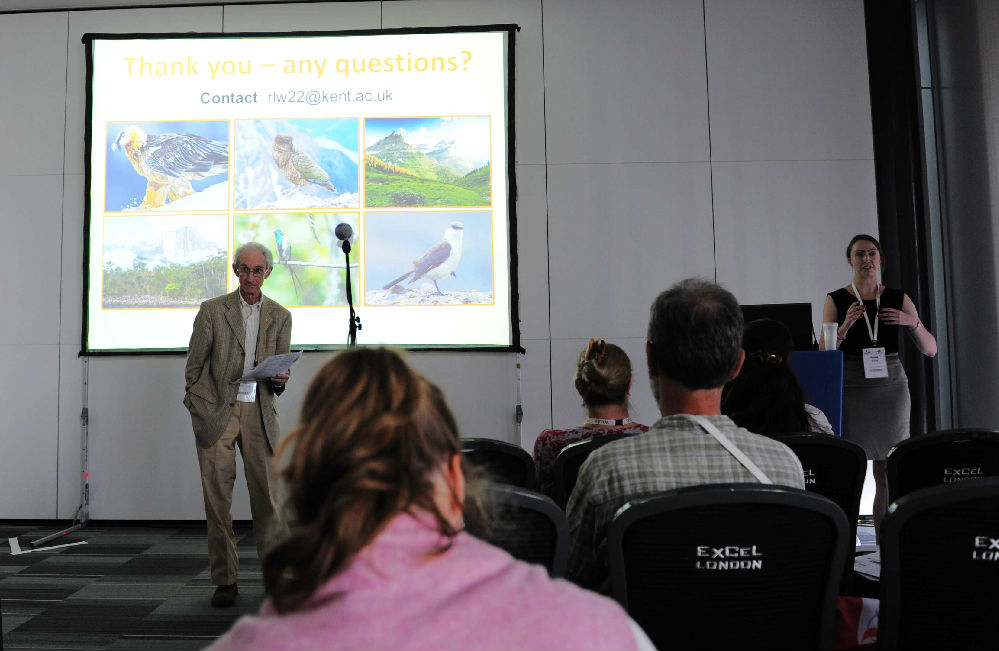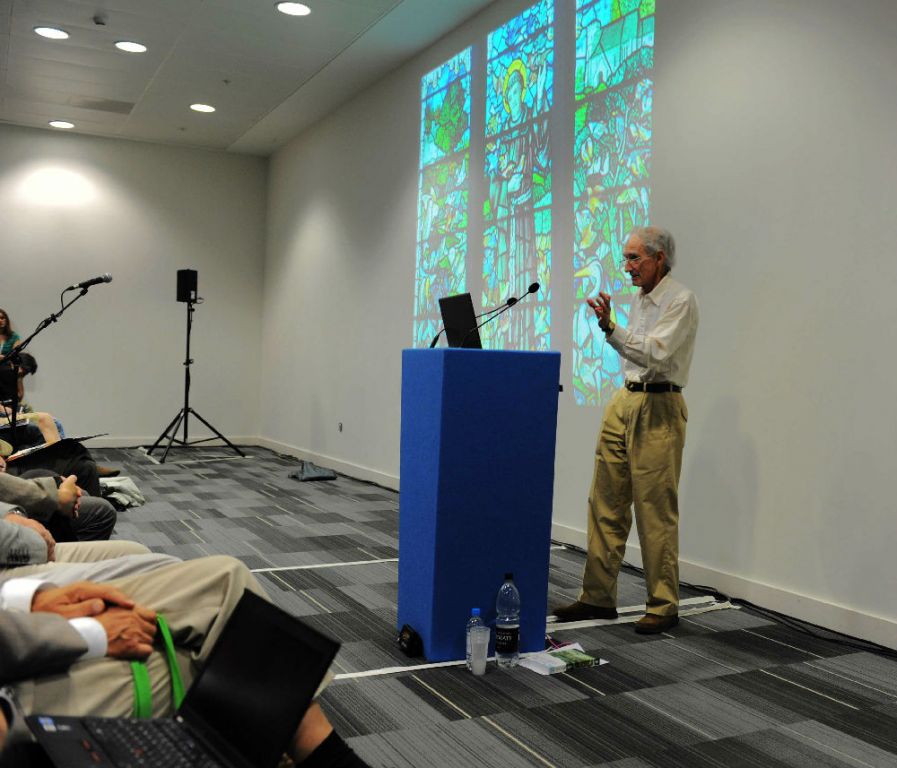博文
现场感受学术大师的魅力
 精选
精选
|||
现场感受学术大师的魅力
(王德华)
11th International Congress of Ecology
ICC London ExCel
INTECOL 2013: into the Next 100 Years
18 to 23 August 2013
第11届国际生态学大会。
日程很满,专题众多,大师云集。
没有纸质的会议摘要集,会议日程安排(活动、报告和墙报)就厚厚的一本。
每天需要提前查看每天的报告内容,忙碌于穿梭在各个会场中,去听自己感兴趣的内容。很多有趣的报告,时间冲突,也只好错过。
学术界对学术大腕还是很崇敬的,尤其是大师级的学者。
在第一天的日程中,发现了Robert May主持一个专题(S5)的下半场:生物地理和生态学。
知道Robert May,是做学生的时候,读过我的博士生导师孙儒泳先生组织翻译的《理论生态学》这本书。虽然看不懂,还是翻过不少次。那本著作也曾在自己的书架上放过多日。
后来也读过R May的文章,如关于生物多样性的文章,关于地球上有多少物种的文章等,关于生态系统稳定性和复杂性的文章等等,都是些理论性很强、很有指导意义的文章。在生态学教科书上,R May的研究成果、理论和思想也已经很普遍了。不知不觉,这位生态学学者逐渐在自己的脑海里形成了“大师”的地位。大师,真不是封的,不是吹出来的,是自然形成的。
早早到了会场,一会儿见到一个穿着西服、消瘦但精神矍铄的老学者走到会场前面坐下,凭感觉他就是R May了。他很认真地主持着,耐心地提醒着每个报告人的时间(每个报告15分钟,包括提问时间)。做报告的青年学者们应该是了解R May的,看得出有些青年学者很激动。
最吸引人的是第三天的专题“Emphasising the importance of basic science in ecology ”(SYMP26),最后一个报告是Robert May,报告题目是Ecology: from cabinets of curiosities to basic scientific understanding. 由于前一个报告人没有到场,主持人提议可以对前面的报告人的问题继续讨论。国际会议上,时间安排很严格,一般不会随便改变日程安排,不会提前和推迟,这样有利于参会者选听自己喜欢的报告。逐渐到了R May的报告时间,会场里的听众逐渐多了起来,最后是会议室都做不下了,周边也站满了听众。一下子就感觉到大学者的学术魅力。专题安排了R May 40分钟的报告,报告讲得很科普,都是大问题,都是很有个人见解的问题。70多岁的老人,在一个小专题上做学术报告,神采飞扬,声音洪亮,时而幽默,时而严肃。他在上台的时候,把自己的西服放在了屏幕下的地毯上,手里拿着打印出来的PPT演讲稿,讲一部分把演讲稿随意丢在地毯上。报告后,蹲下身来捡拾起报告期间丢在地毯上的演讲稿。你怎么看,都不像学术大师,可这就是活生生的学术大师。从报告结束后听众的掌声,就知道大家对他是多么尊重。尊重,不是帮他提包,帮他拿衣服,帮他捡演讲稿,跟他合影,让他签名….整个过程,你就是感到尊重和敬仰。报告后的问题提问时间,更是达到了高潮。你在现场就体会到了什么是真正的学术大腕。尽管学术会议期间,一般不欢迎拍照,面对那个激动的场面,我还是忍不住拿出了相机。
也曾记得2005年在日本召开的国际哺乳动物学大会上,种群生态学家Charles Krebs 在会议上只有一张墙报,墙报内容很简单,很显眼的就是墙报中间那张澳大利亚小家鼠大爆发的黑白图片。在茶歇时间,他的墙报前俨然成了一个学术会场,大家围在他的周围,聆听他的演讲。这就是大学者的影响力,大学者的胸怀和风范。
关于Robert May的简历大家可以到网络上查一下,他的那些头衔那一条都不得了。就是这样一位有着显赫地位的大科学家,看不出一点盛气凌人的架势来。
以下信息来源于牛津大学动物学系的网站:
Robert, Lord May
简历:
l Professorship at Oxford University
l Fellow of Merton College, Oxford.
l President of The Royal Society (2000-2005),
l Chief Scientific Adviser to the UK Government and Head of the UK Office of Science and Technology (1995-2000).
l Member of the UK Government’s Climate Change Committee (an independent body established by the Climate Change Bill, to advise on targets and means of achieving them),
l Non-Executive Director of the UK Defense Science & Technology Laboratories
l Chaired the Trustees of the Natural History Museum.
His career includes
l Personal Chair in Physics at Sydney University aged 33
l Class of 1877 Professor of Zoology
l Chairman of the Research Board at Princeton,
l Move to Britain and Oxford as Royal Society Research Professor in 1988.
研究兴趣:
l How populations are structured and respond to change, particularly with respect to infectious diseases and biodiversity;
l The structure and dynamics of ecosystems (and – more recently – other networks, such as banking systems), with particular emphasis on their response to disturbance, natural or human-created
荣誉:
l He was awarded a Knighthood in 1996, and appointed a Companion of the Order of Australia in 1998, both for “Services to Science”.
l In 2001 he was one of the first 15 Life Peers created by the “House of Lords Appointments Commission”, which was established as an independent mechanism for appointing non-party-political Peers following the removal of the voting rights of hereditary Peers.
l In 2002, The Queen appointed him to the Order of Merit (the fifth Australian in its 100-year history).
l His many honors include: the Royal Swedish Academy’s Crafoord Prize (bioscience and ecology’s equivalent of a Nobel Prize);
l the Swiss-Italian Balzan Prize (for “seminal contributions to [understanding] biodiversity”);
l Japanese Blue Planet Prize (“for developing fundamental tools for ecological conservation planning”).
l Foreign Member of the US National Academy of Sciences,
l Overseas Fellow of the Australian Academy of Sciences,
l Honorary Fellow of the Royal Academy of Engineering
l In 2007 he received the Royal Society’s Copley Medal its oldest (1731) and most prestigious award, given annually for “outstanding achievements in research in any branch of science”.
代表作:
May, R.M. & McLean, A.R. (Eds). (2007) Theoretical Ecology: Principles and Applications. Oxford University Press, Oxford. Pp. 257 + ix
May, R.M. (2004) Uses and abuses of mathematics in biology. Science, 303, 790-793
May, R.M. (2006) Network structure and the biology of populations. TREE, 21 No.7 July, 394-400
Hsieh, C-h., Reiss, C.S., Hunter, J.R., Beddington, J.R., May, R.M & Sugihara, G. (2006). Fishing elevates variability in the abundance of exploited species. Nature, 443, 859-862
May, R.M., Sugihara, G & Levin, S.A. (2008). Ecology for Bankers Nature, 451, 893-895

R May 主持青年报告专题

R May 在专题会议上做报告。左上方屏幕下面是他的西服。

R May 走进听众席,回答代表的问题。
https://blog.sciencenet.cn/blog-41757-721414.html
上一篇:博士学位论文答辩:“让学生放松和舒服”
下一篇:人以群分